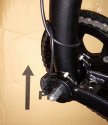Grin All-Axle on Q45 - cable hook.
This motor works with thru-axles, but is intended for front forks. The 'All-Axle' moniker is fulfilled by interchangeable pairs of adaptors to fit the motor for the different axles.
The geometry of the Q45 puts the cable dangerously close to the spinning disk rotor, which acts as a saw. Aldo of Quantum Bicycles came up with an approach of machining a new left-side axle adaptor that also sports a hook that positively holds the cable away from the brake rotor.
The form mimics the Grin-supplied 12mm thru-axle adaptor for the motor, with an Inside shaft fitting into the 20mm axle bore of the motor, an Outside shaft contacting the inside of the bicycle fork (rear swing-arm in the case of the Q45), and a flange between which stops the adaptor from sliding further into the motor axle bore.
There is a groove on the outer circumference of the Inside shaft which holds an o-ring and matches a groove inside the 20mm bore of the motor axle to act as a stop to hold the adaptor in place when the wheel is removed.
This adaptor is largely the same, except that the flange between the Inside shaft and Outside shaft is much wider (not thicker) to provide space for a hook that positively holds the motor cable away from the brake rotor.
The hook is formed by a channel cut into the flange reaching perhaps 40 degrees around the circumference of the adaptor, open to the outside, closing at the inside end flush against the Inside shaft.
I think the profile of the adaptor is two circles - one coincident with the thru-axle and wheel axis, and the second describing the outer diameter of the Hook flange, with an OD of 39.2mm.
It is not easy to determine the offset between the two axes manually with calipers, but laying out two circles with the measurements below will provide a layout that is close enough.
I DON'T measure from the 'centre' - there's a hole. I measure from either the Inside shaft or the Outside shaft to the point on the flange/Hook plate in between.
Inside shaft - probably matching original Grin 12mm thru-axle adaptor
OD: <20mm - permit insertion into bore of motor axle.
ID: 12mm - permit insertion of 12mm thru-axle used by Q45.
Depth inwards from Hook plate: ~12mm (no contact, so not critical)
End bore of Inside shaft is countersunk to avoid contact with thru-axle thread, but not so deep that it intersects the OD
Outside shaft/boss - analogous to same feature on original Grin 12mm thru-axle adaptor, but check this. I didn't.
OD: 17.1mm - probably matches Grin-supplied 12mm thru-axle adaptor
Protrusion outwards towards swing-arm from Hook plate: 2.25mm, 2.10mm, 2.14mm - not so critical as long as it's greater than the 2.1mm length. It may widen the swing-arm distance slightly.
Hook plate - formed from flange between Inside shaft and Outside shaft/boss
Thickness: 1.1mm - 1.25mm - probably can be a little thicker, I think Aldo of Quantum said it's 1.7mm, but these were my measurements. It's thin and can be bent. He sandblasted to harden it, and I had it anodised for corrosion resistance.
At closest, inside of the channel for the cable matches OD of Inside shaft - it's flush.
Channel width is <7mm, at it's closed end it is rounded, and it turns out smoothly at it's open end so that the direction of the channel is radial there.
Repeating the description above, the channel is circumferential about the 20mm OD of the Inside shaft, and as it exits to the outside this channel also turns so that the channel is radial as it exits. The turn is smooth and rounded.
However, a small segment of the exit, on the side opposite the 'point' of the hook, just at the outer edge, is straight. I don't think this is a feature, it just expands the outlet where it does not matter.
The line from the axis of the Inside/Outside shaft to the centre of the outer circle of the Hook plate appears to be through the centre of the motor cable when that is full engaged in the channel.
I estimate a 6mm offset between the two centres.
The closest approach of the outside of the Hook Plate appears to be opposite the centre of the motor cable when the cable is engaged the deepest at the end of the channel, and this is 7mm from the OD of the Outside shaft/boss.
The greatest distance is about opposite at 15mm from the OD of the Outside shaft/boss.
The outside of the small segment where the grub screw touches is 10.7mm from the Outside shaft/boss. You can see the grub screw in the detail - it prevents the adaptor from rotating (technically it's not a 'grub screw' - it's a countersunk screw doing duty).
The measurements just above of the Hook plate are from the Outside shaft/boss, but recall the channel for the cable is flush with the slightly larger Inside shaft so don't be confused that the width of the channel is about 6.8mm.
















